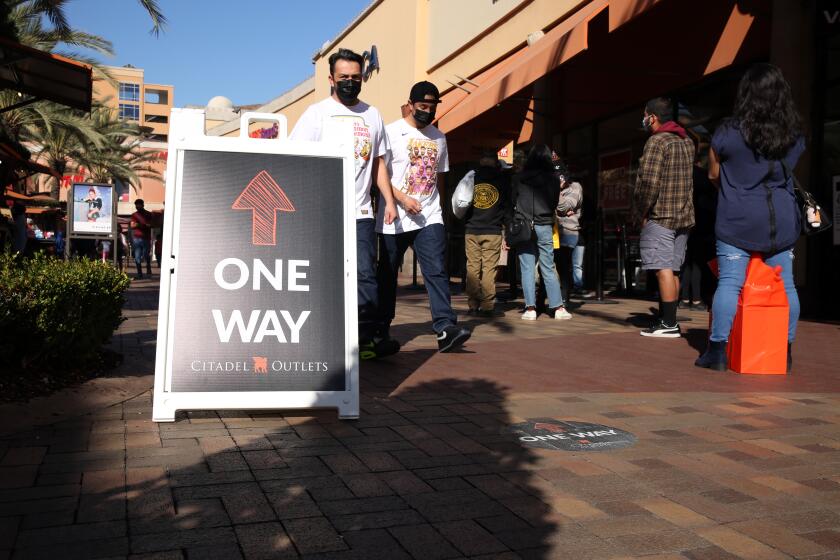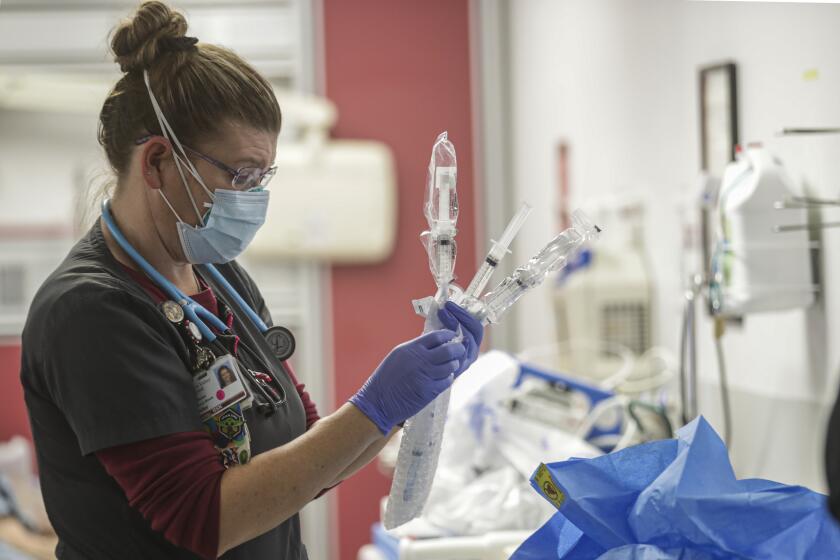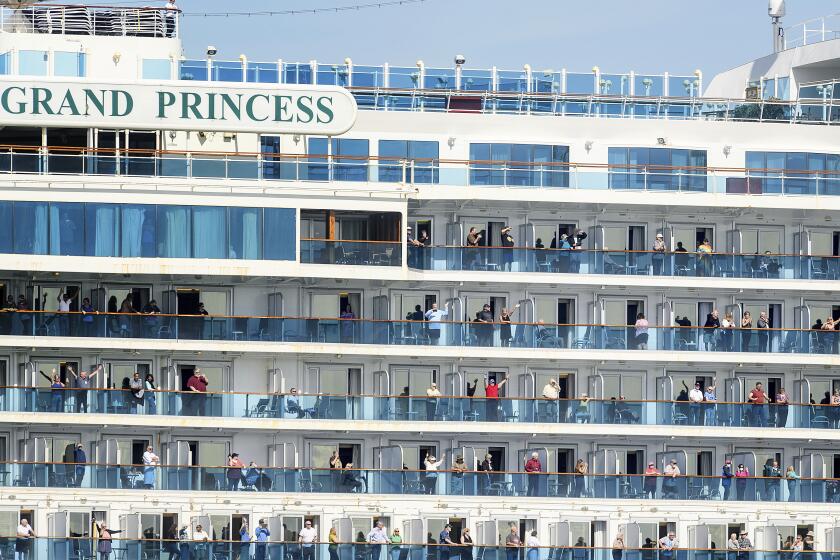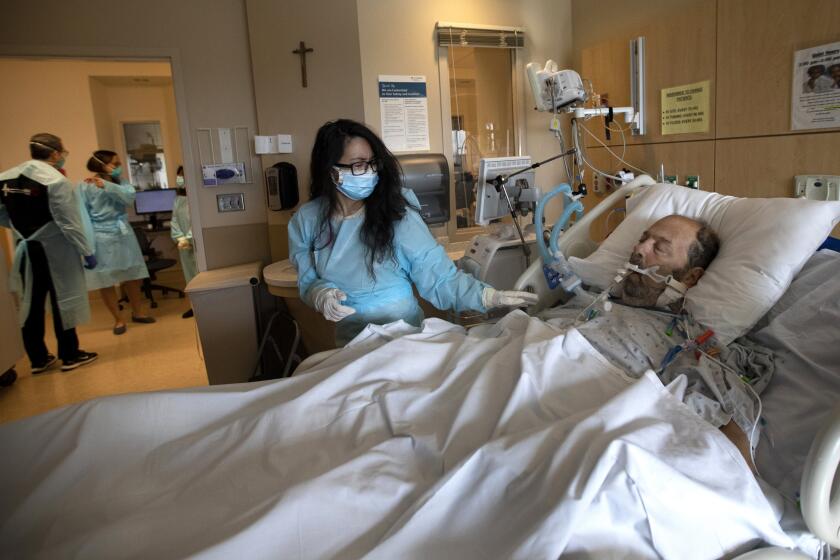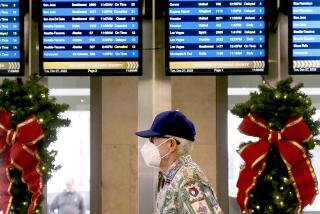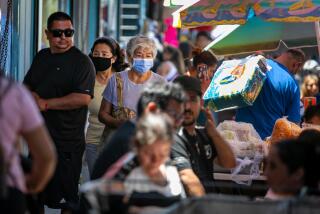COVID-19 surges at L.A. County shopping malls as holiday customers pack stores

- Share via
Paola Hernández watched as shoppers at the Citadel Outlets bumped shoulders and ignored signs directing foot traffic under bow-adorned palm trees. Two girls stood a few feet behind her licking ice cream cones, even though eating has been banned in malls.
Hernandez, 57, and her daughter went to the outdoor mall in Commerce on Monday when they weren’t able to find the holiday presents they wanted to buy online, she said. But even sitting on a bench outside had started to feel unsafe when, despite a sign stating it seated only two, a third person sat down next to her.
“I do feel scared. ... A lot of us don’t follow the rules. That’s the problem,” said Hernandez, who lives in El Monte. “The virus is in the air.”
In this latest, most dire phase of the pandemic, as millions of Californians have been asked to stay home and avoid their families for the holidays, packed shopping malls have become a flashpoint.
In recent weeks, Los Angeles County officials have banned outdoor dining, temporarily closed playgrounds and shuttered nail and hair salons. Yet, as case numbers continue to rise unabated and hospitals warn they may soon be forced to ration care, malls have continued to welcome holiday shoppers.
Here are safety tips for getting your holiday shopping done at malls and shopping centers amid the COVID-19 surge.
Shopping malls and retail businesses deemed nonessential must limit occupancy to 20% of their maximum capacity, under county rules. But in the eyes of many, even public officials, they remain unsafe.
L.A. County health services director Dr. Christina Ghaly said that recent images of busy shopping centers worried her. On Saturday, an NBC News video sparked outrage online after showing cars vying for parking spots at the Citadel.
“If you’re still out there shopping for your loved ones for this holiday season ... then you are missing the gravity of the situation that is affecting hospitals across L.A. County,” Ghaly said Monday. “Though they may seem benign, these actions are extremely high-risk.”
The numbers show the coronavirus circulating statewide; behaviors thought to be relatively safe weeks ago now carry a higher risk of infection.
Indeed, as COVID spreads faster than ever in L.A. County, it has reached malls, too. The vast majority of outbreaks reported at shopping malls during the pandemic were reported in the past four weeks, according to a Times analysis of data posted on the county’s website. An outbreak is defined as three or more cases among staff in a 14-day period.
At the Northridge Fashion Center, 12 J.C. Penney employees recently tested positive for the coronavirus, as did 10 at Kohl’s in the South Bay Galleria in Redondo Beach and 24 at the Best Buy in the West Hollywood Gateway retail center, which prompted a six-day closure of the store.
New outbreaks have also been reported at Vans in the Burbank Town Center, Zara at the Glendale Galleria and Forever 21 at the Montebello Town Center.
The cases don’t necessarily reflect unsafe practices on the part of companies as much as the difficulty of controlling spread when prevalence of the virus is this high, experts say.
Outbreaks are soaring across industries, with 505 businesses in L.A. County in the midst of one as of Tuesday, compared with 204 a month ago, according to county data.
California becomes first state to surpass 2 million coronavirus cases
To many, the flare-ups at retail stores and shopping malls exemplify the contradiction of L.A.’s current COVID rules: Stores that sell nonessential goods, such as books, jeans and TVs, remain open for in-store browsing, while officials warn that it is dangerous to leave the house unless absolutely necessary.
“It’s like telling little kids, ‘You can’t have a lollipop, but I’m going to put one right there in front of you,’” said Reina Morataya, a manager at a clothing store at Plaza El Segundo, where customers have been flooding in recent days.
The economic decision to keep stores open — compelled by a lack of federal relief to help ailing businesses — has muddied the public health message, said UCLA epidemiology professor Shira Shafir.
“There’s been so much messaging in the pandemic that said, ‘It’s not safe for X to be open, so we’re going to close X,’” she said. “It’s totally reasonable for people to then interpret the inverse: ‘If it’s open, it must be safe.’”
Even as the situation in L.A. County careens toward catastrophe, public health director Barbara Ferrer said Monday she was not considering further closures, noting that retail is already at a “much-reduced” 20% capacity.
“Stay home,” she said.
The Grand Princess cruise ship floated off the California coast for days while officials wrestled with the emerging coronavirus outbreak. Here’s what it was like on board.
At the Citadel Outlets on Monday, a line snaked outside the Calvin Klein store, where an outbreak infected three staff members earlier this month. Inside the mostly empty store, shoppers had plenty of room to space out and employees in masks frequently approached the hand sanitizer dispenser.
But the rest of the outdoor mall was a free-for-all, where customers brushed past one another in their rush to their next destination, forming looping queues as they waited to get into stores.
At an outdoor kiosk selling anime figurines, an employee sprayed her hands with sanitizer. She pointed to shoppers walking by, disobeying the one-way signs, and said she worries when customers get too close.
“But what to do? We have to pay the rent,” she said.
Shopping malls and retail stores were closed in the early months of the pandemic, as widespread shutdowns prohibited almost all indoor activities. In-store shopping was restarted in early May, and indoor malls followed in October as COVID-19 spread in L.A. County hit a low point.
Bob Harris told his family he didn’t want to be on a ventilator, but when his family wasn’t ready for him to stop fighting COVID-19, he agreed to be intubated. One week on the ventilator turned into three, and the Harris family faced a terrible decision.
But when more people began to fall sick the following month, officials tried to curb the spread while also closing as few stores as possible, as federal relief for businesses had dried up.
So while taking a masked walk with a friend was banned under the new orders, retail shops remained open at 20% capacity.
As comedian Johan Miranda tweeted, “Just told my mom under Los Angeles stay at home orders I can’t see her unless we happen to be shopping at the same Target.”
The decisions to keep these stores open have not been without health consequences.
Workplaces are an ideal setting for the spread of COVID-19 — indoor environments where people interact in close quarters for hours on end. Even a classic Southern California outdoor mall does not help much, since the workers spend all day inside the stores.
Outbreaks have been reported this month at the Apple Store at the Beverly Center, Michaels in the Burbank Empire Center as well as Amazon Books and Nordstrom at the Los Cerritos Center.
Half of the outbreaks reported at Target stores in L.A. County during the pandemic were reported in December. Five Costco branches have been hit with outbreaks in the past two weeks, and at least 135 staff have been infected, according to county records.
Representatives from impacted companies told The Times they have followed all protocols and that cases often originate outside the workplace. Apple opted on Saturday to close all its California stores “out of an abundance of caution as we closely monitor the situation,” a spokesperson said.
Rachel Michelin, president of the California Retailers Assn., said the organization has asked the state for information that would help determine whether infections are coming from shopping centers, but the requests have gone unanswered.
Without that clarity, retailers are moving forward with their best efforts to keep shoppers and employees safe, she said.
“We’ve openly said if retail is a major problem in transmission of COVID-19, show us the data,” Michelin said. “We can’t just blame businesses for behavior of people who are going out and having parties or going to other households.”
L.A. County chief medical officer Dr. Jeffrey Gunzenhauser said the high number of workplace outbreaks is mostly a reflection of how widespread the coronavirus is in the county — currently 1 in 80 residents are believed to be infectious.
Contact tracing interviews from the first half of December found that among people who contracted COVID-19 and were employed, 8% worked in retail, he said.
“When people hear there’s a lot more outbreaks in facilities, they think there’s a lot of transmission going on there, and that isn’t necessarily true,” he said. “It’s just because there are so many cases.”
Since late August, county investigators have fined businesses up to $500 each time they seriously violate COVID safety precautions.
The Citadel has been fined four times since November, according to county records. In response, the mall “took the feedback from health officials seriously” and improved signage telling people not to eat or drink, made walkways wider, ensured proper spacing in lines, canceled all live events and expanded curbside pickup options, said Citadel general manager David Blagg.
“We’re pleased to share that we received another visit from Los Angeles County Department of Public Health yesterday and were found compliant,” he wrote in an email Tuesday.
More to Read
Sign up for Essential California
The most important California stories and recommendations in your inbox every morning.
You may occasionally receive promotional content from the Los Angeles Times.
